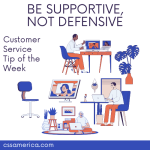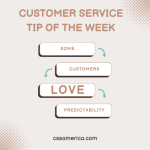 Thank you for your patience. That’s a statement I enjoy saying…when I am the customer.
Thank you for your patience. That’s a statement I enjoy saying…when I am the customer.
When I’m trying to learn something and I’m about to go into a process, I want to have a feel for what the whole process involves. Over the years, I’ve gotten tired of feeling like I’ve completed a process, when in reality I’ve only gotten through the first step. I hate coming to the end of the first step and finding that there’s a second step, getting to the end of the second step, and only then finding that there’s a third step. It would be so much better to just know all the steps, the entire timeframe, and what I need to do from the start to make all these steps go as smoothly and quickly as possible.
Again, I’m talking from the perspective of the customer. Whether it is talking to account representative about some new service or talking to the computer tech helping me deal with a blinking computer screen, I like to know the steps.
In these situations, I am asking a lot of questions, and things I appreciate most about a person are (1) The specific responses conveyed with knowledge and experience as well as (2) Patience.
Customer Frustrations
It bothers me to no end when I feel like the person is rushing through the conversation. It’s frustrating when they’re making the process sound like it’s not that big a deal; it probably isn’t a big deal to them since they’ve dealt with it 100 times, but it is a big deal to me, the customer. It’s frustrating when they talk fast or make statements unrelated to my need because they didn’t ask questions about what’s unique about my situation.
Avoiding their Frustrations
So, what is not frustrating? What is positive? Knowledge and experience conveyed in specific responses…and patience. When you’re dealing with somebody who’s about to go through a series of steps, convey these attributes.
Be patient. Think about your body language. Avoid interrupting. Breathe a few times to slow yourself down. Ask them questions to understand their situation so you don’t have to talk about the 5 different paths something might take if it’s obvious this process is going to go down 1 path for this 1 unique customer’s 1 situation.
Let your patience result in a positive customer experience.
Signup for FREE Tips! Contact Us More Resources for You Visit Our Home Page














 Have you ever walked into a patient registration area of a hospital and seen a sign that said “if you’ve been waiting longer than 15 minutes, please see the receptionist?”
Have you ever walked into a patient registration area of a hospital and seen a sign that said “if you’ve been waiting longer than 15 minutes, please see the receptionist?” The customer was throwing an absolute fit in the lobby. Sitting among several other customers waiting for her number to be called, she was raising her voice and letting out the occasional expletive about the lengthy wait time. An employee sitting behind the counter thought to herself: I’m going to ignore her and not make eye contact and hope somebody else deals with her.
The customer was throwing an absolute fit in the lobby. Sitting among several other customers waiting for her number to be called, she was raising her voice and letting out the occasional expletive about the lengthy wait time. An employee sitting behind the counter thought to herself: I’m going to ignore her and not make eye contact and hope somebody else deals with her.






